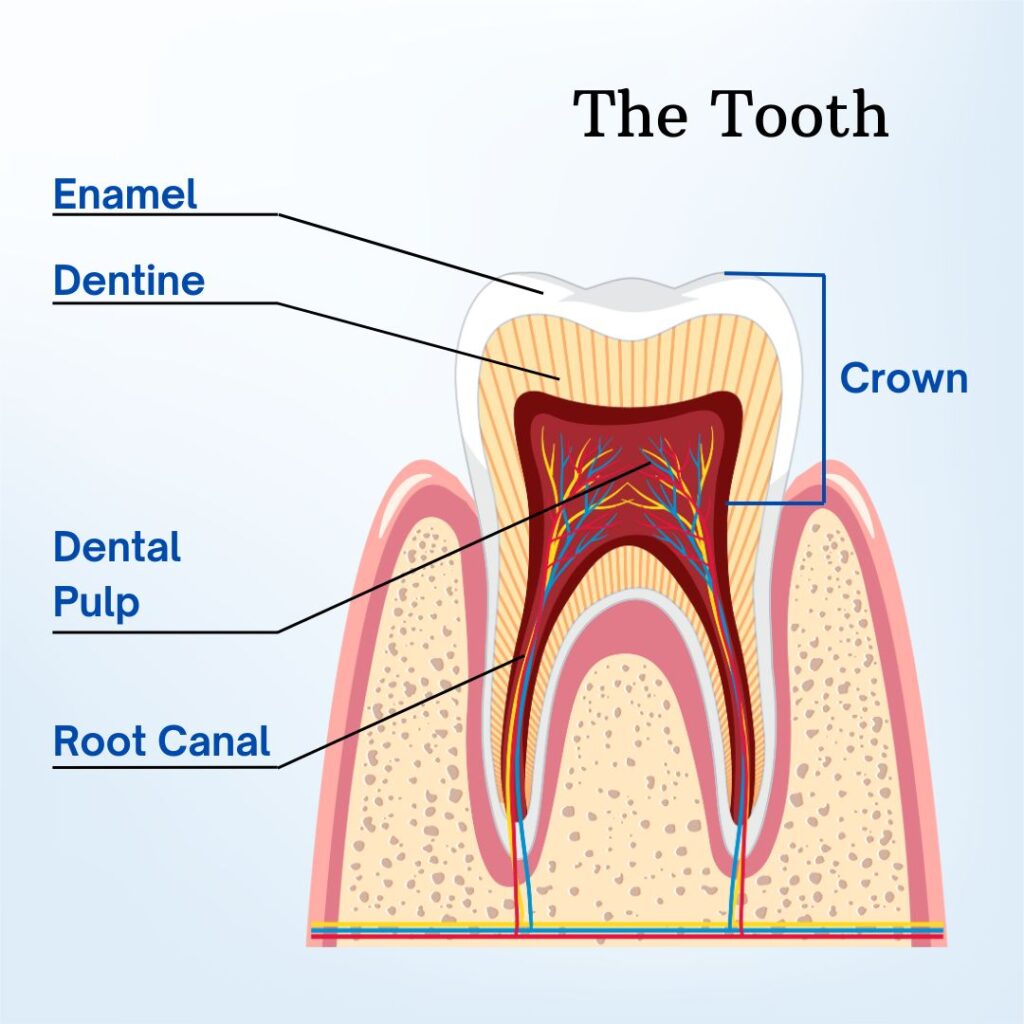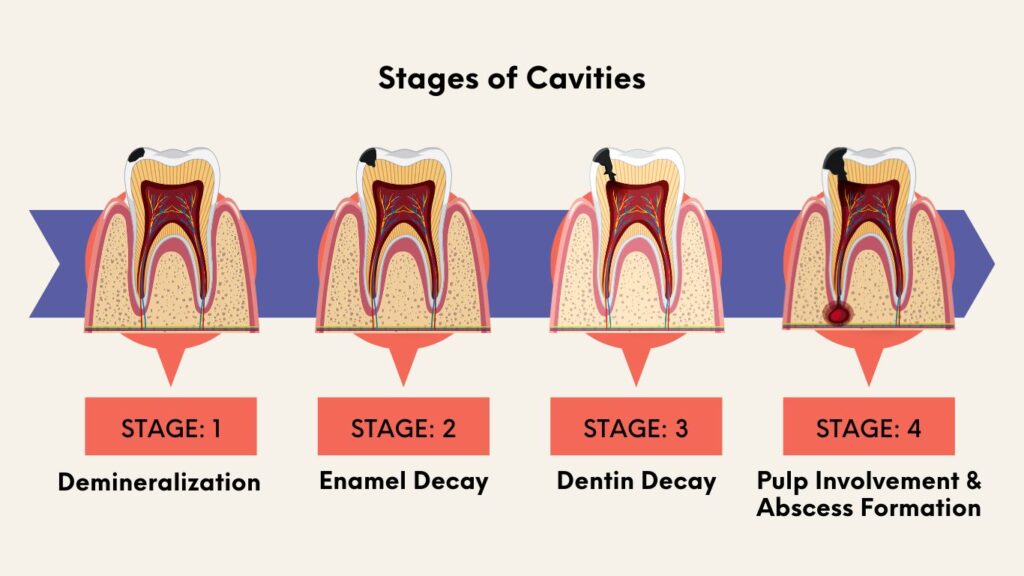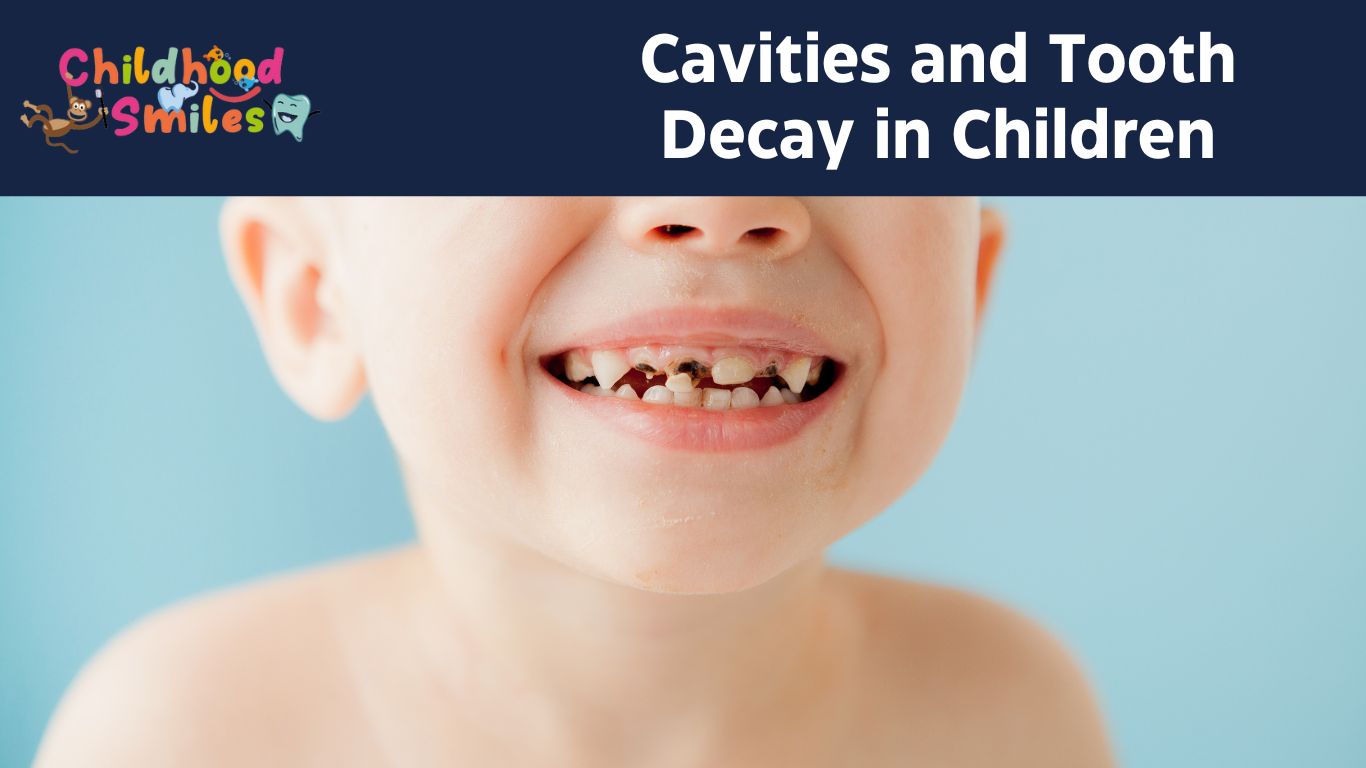Cavities and Tooth Decay in Children
Cavities and tooth decay in children are increasingly common, affecting millions of kids worldwide. As a parent, understanding the causes and prevention of this dental issues is essential for your child’s long-term oral health. Cavities, also known as dental caries, occur when tooth enamel (outer layer of tooth) breaks down, leading to holes and potential infections. In this blog, we’ll explore everything you need to know about cavities and tooth decay in children, from early signs and symptoms to effective prevention and treatment strategies. Keep reading to protect your child’s smile and ensure a lifetime of healthy teeth.
Understanding Cavities and Tooth Decay
What Are Cavities / Tooth Decay in Children?
Cavities, also known as dental caries, are permanently damaged areas on the surface of your child’s teeth that develop into tiny holes or openings. These are the result of a complex process of tooth decay, which happens gradually over time. Cavities can affect anyone, but they are particularly common in children due to their developing oral hygiene habits and diets that often include sugary snacks and drinks.
How Cavities Form?
Tooth decay begins with the accumulation of plaque (a sticky film of bacteria that forms on the teeth). When children don’t brush and floss regularly, plaque accumulates on their teeth, particularly in hard-to-reach areas like the molars (back teeth).
When your child consumes food or drinks, especially those high in sugars and starches, the bacteria in plaque feed on these sugars and produce acids. These acids attack the tooth enamel (protective outer layer of the tooth), which then dissolve the minerals in the tooth enamel.
This process, called demineralization, weakens the enamel, making it more susceptible to decay. Without proper oral hygiene and regular dental care, this cycle of plaque formation and acid production continues.
Over time, repeated acid attacks erode the enamel, leading to the formation of cavities. If the initial cavities left untreated, the decay can penetrate deeper into the tooth, reaching the dentin and even the pulp (inner most layer of the tooth), causing pain, infection, and more severe dental issues. This may need more extensive invasive treatment called pulpetctomy.

Early Childhood Caries in Baby / Milk Teeth
Early Childhood Caries (ECC) is the most common form of tooth decay that affects the baby/milk teeth of infants and toddlers. Every second child in India is suffering from it. It is also commonly known as “baby bottle caries.” This condition is usually caused by prolonged exposure to sugary liquids, such as milk, juice, or even sweetened pacifiers.
Baby teeth are crucial for a child’s development. They help with chewing, speaking, and guiding the proper growth of permanent teeth. When these teeth are affected by cavities, it can lead to pain, infections, and long-term dental issues.
The 4 Stages of Cavities
Cavities develop gradually over time and can be divided into four distinct stages. Understanding these stages can help parents recognize the early signs of tooth decay in their children and take action before the problem worsens.

1. Demineralization: The Early Stage
The first stage of a cavity is demineralization. This occurs when the enamel, the outer protective layer of the tooth, begins to lose minerals.
In this stage, you may notice white spots appearing on the tooth’s surface, especially along the gumline. These spots indicate areas where the enamel is weakening, but the decay can still be reversed with good oral hygiene and preventive dental treatments. This is the best time to intervene and prevent further damage.
2. Enamel Decay
If the early stage is not treated, the decay progresses into the enamel itself. At this stage, the decay creates small holes, known as cavities or caries, in the tooth’s surface.
During this phase, the cavity might not yet be painful, making it harder to detect without regular dental check-ups.
3. Dentin Decay
The next stage of a cavity is dentin decay. The dentin is the softer layer beneath the enamel and is more susceptible to acid attacks. Once the decay reaches this layer, the cavity expands more rapidly.
This stage often results in increased sensitivity to hot, cold, or sweet foods, as the dentin connects directly to the tooth’s nerves. If your child complains of tooth sensitivity, it’s a strong indicator that the decay has advanced beyond the enamel.
4. Pulp Involvement and Abscess Formation
The final and most severe stage is when the decay reaches the pulp, the innermost part of the tooth that contains nerves and blood vessels. Once bacteria invade the pulp, the tooth becomes infected, leading to severe pain, inflammation, and possibly an abscess—a pocket of pus that forms at the root of the tooth.
At this point, the damage is extensive, and treatments like pulpectomy or even tooth removal may be necessary.
Signs and Symptoms of Tooth Decay
Recognizing the signs and symptoms of tooth decay early can help prevent more serious dental issues in your child. Tooth decay often starts silently, so it’s important to be aware of both visible and less obvious indicators that something might be wrong with your child’s teeth.
1. White Spots or Discoloration particularly along the gumline. These white spots can darken over time, leading to brown or black stains as the decay progresses.
2. Your child may experience Sensitivity to certain foods and drinks. This sensitivity often occurs when consuming hot, cold, or sweet items. Sensitivity is a strong indication that the tooth enamel is weakening and the cavity is growing.
3. Visible holes or pits in teeth. You might notice these holes when your child opens their mouth wide or complains about something feeling “off” when they bite or chew.
4. Toothache or Pain. Your child may complain of pain in a specific tooth or in their mouth, which can range from mild discomfort to severe, throbbing pain. This pain might be constant or triggered by eating, drinking, or even breathing in cold air.
5. In severe cases, tooth decay can lead to swelling or the formation of an abscess. An abscess is a pocket of pus that develops around the tooth root, causing significant pain and swelling in the gums and face.
6. Persistent bad breath or an unpleasant taste in the mouth can also be signs of tooth decay. If your child’s bad breath persists despite regular brushing, it may indicate that cavities are present, and a dental check-up is needed.
Causes of Cavities in Children
Understanding these causes can help parents take preventive steps to protect their child’s oral health.
1. Poor Oral Hygiene Habits: One of the leading causes of cavities in children is poor oral hygiene. Brushing at least twice a day and flossing daily are crucial habits to prevent plaque accumulation and reduce the risk of cavities.
2. Sugary and Acidic Foods and Drinks: Children’s diets often include a variety of sugary and acidic foods, such as candy, soda, fruit juices, and snacks. Frequent consumption of sugary snacks or drinks exposes teeth to repeated acid attacks, making cavities more likely to develop.
3. Lack of Fluoride: Fluoride is a mineral that helps strengthen tooth enamel and makes it more resistant to decay. Children who do not get enough fluoride are at a higher risk of developing cavities.
4. Bottle Feeding and Pacifier Use During Bedtime: When children go to bed with a bottle, the sugary milk can pool around their teeth, providing a constant source of food for bacteria that cause decay. Similarly, dipping pacifiers in sweet substances can also contribute to cavities.
5. Frequent Snacking: If your child snacks frequently, their teeth are exposed to acid attacks more often, leading to a higher likelihood of decay.
Complications Cavities Can Cause
When left untreated, cavities in children can lead to several complications that go beyond simple tooth decay. These complications can affect not only your child’s dental health but also their overall well-being.
1. Tooth Pain and Discomfort: As the decay progresses deeper into the tooth, it can cause significant discomfort. This pain can range from mild sensitivity to severe, throbbing pain that makes it difficult for your child to eat, speak, or concentrate in school. Persistent tooth pain can also interfere with your child’s sleep and overall quality of life.
2. Infections and Abscesses: When a cavity reaches the pulp (the innermost part of the tooth), it can lead to a tooth infection. This infection can spread, causing swelling in the gums, face, or jaw. In more severe cases, an abscess (a painful, pus-filled pocket) may form at the root of the tooth. Dental abscesses are serious and require immediate medical attention, as the infection can spread to other parts of the body, leading to more severe health problems.
3. Tooth Loss: The decay weakens the tooth structure to the point where it cannot be saved. Losing a tooth, especially a baby tooth, can cause alignment issues as the permanent teeth grow in. Additionally, premature tooth loss can impact your child’s ability to chew food properly and affect their speech development.
4. Impact on Permanent Teeth: Untreated decay can damage the underlying permanent teeth, leading to developmental issues. In some cases, the infection can spread to the adult teeth before they even emerge, causing them to develop with defects.
5. Difficulty Eating and Nutritional Issues: Tooth pain and discomfort from cavities can make it difficult for your child to eat properly. They may avoid certain foods, particularly those that are hard, cold, or sweet, leading to an unbalanced diet. Poor nutrition during childhood can affect your child’s growth and overall health.
6. Speech Problems: Cavities and tooth loss, especially in the front teeth, can lead to speech problems in young children. Teeth play a crucial role in forming sounds, and missing or damaged teeth can make it difficult for your child to pronounce certain words correctly.
7. Self-Esteem and Social Issues: The appearance of cavities, particularly if they lead to visible damage like blackened or missing teeth, can impact your child’s self-esteem. They may feel embarrassed about their smile, which can affect their interactions with peers and social development.
Treatment Options for Cavities in Children
Depending on the severity of the cavity, there are several effective treatment options available to restore your child’s dental health.
1. Fluoride Treatments: For early-stage cavities, fluoride treatments can help prevent the cavity from progressing. Fluoride treatments involve applying a concentrated form of fluoride to the affected area. This mineral helps to remineralize the enamel, making it stronger and more resistant to further decay. Fluoride treatments are quick, painless, and can often reverse the early signs of tooth decay.
2. Dental Fillings: For cavities that have progressed beyond the early stages, a dental filling is the most common treatment. During this procedure, the dentist will remove the decayed portion of the tooth and then fill the space with a biocompatible. Fillings restore the tooth’s shape and function, preventing further decay.
3. Dental Crowns: In cases where the cavity is too large for a simple filling, a dental crown may be necessary. A crown is a custom-made cap that covers the entire tooth, restoring its shape, size, and strength. Crowns are typically made of stainless steel for baby teeth, which are durable and designed to fall out with the tooth when it naturally sheds. For permanent teeth, crowns can be made from materials like zirconia, which looks similar to the surrounding teeth.
4. Pulpotomy: When decay reaches the pulp (the innermost part of the tooth) a pulpotomy may be required. This treatment involves removing the infected or damaged pulp while preserving the healthy portion. The dentist then fills the space with a biocompatible material and seals the tooth with a crown. Pulpotomies are commonly used for severe decay in baby teeth, allowing the tooth to remain functional until it naturally falls out.
5. Tooth Extraction: In cases where the cavity has caused extensive damage and the tooth cannot be saved, a tooth extraction may be necessary. While dentists try to preserve baby teeth whenever possible, sometimes removing the tooth is the best option to prevent infection and protect the surrounding teeth. If a tooth is extracted, a space maintainer may be used to keep the gap open until the permanent tooth comes in. This device is essential for preventing misalignment and ensuring that surrounding teeth don’t shift into the empty space. Space maintainers can be custom-made and are typically removed once the adult tooth begins to emerge.
6. Root Canal Therapy: In rare cases, when a child’s permanent tooth is affected by severe decay or infection, root canal therapy may be necessary. This procedure involves removing the infected pulp, cleaning the inside of the tooth, and sealing it to prevent further infection. It is essential for saving permanent teeth and maintaining a healthy bite and smile.
Preventing Cavities and Tooth Decay in Children
Prevention is the best way to protect your child from cavities and tooth decay. By establishing healthy habits early, you can help ensure your child maintains strong, healthy teeth for life.
1. Establish Good Oral Hygiene Habits Early: Teaching your child good oral hygiene habits from a young age is crucial in preventing cavities. This includes:
- Brushing Twice a Day: Ensure your child brushes their teeth at least twice a day using fluoride toothpaste. Use a soft-bristled toothbrush and help them brush until they develop the motor skills to do it effectively on their own.
- Flossing Daily: Flossing removes food particles and plaque between teeth where a toothbrush can’t reach. Start flossing as soon as your child has two teeth that touch.
- Supervised Brushing: For younger children, supervise their brushing to ensure they are doing it correctly.
2. Healthy Eating Habits: Your child’s diet plays a significant role in their dental health. To prevent cavities:
- Limit Sugary Snacks and Drinks: Sugary foods and drinks fuel the bacteria in the mouth that cause tooth decay. Limit sweets, sodas, and juices, and encourage your child to drink water instead.
- Encourage Healthy Snacks: Offer your child nutritious snacks such as fruits, vegetables, cheese, and yogurt. These foods not only support overall health but also help protect teeth by stimulating saliva production and neutralizing acids.
- Avoid Constant Snacking: Frequent snacking keeps your child’s teeth exposed to acid attacks throughout the day. Encourage regular meals and limit snacking between them.
3. Regular Dental Visits: Regular check-ups with a pediatric dentist are essential for preventing cavities and tooth decay. During these visits:
- Professional Cleanings: The pediatric dentist will remove plaque and tartar buildup that regular brushing might miss.
- Early Detection: Regular checkups allow the dentist to spot early signs of cavities or other dental issues and address them before they become serious problems.
- Dental Education: The dentist can provide tips on improving your child’s oral care routine and answer any questions you might have about their dental health.
4. Fluoride Treatments: Fluoride is a powerful tool in the fight against cavities. It strengthens tooth enamel and can even reverse early signs of tooth decay. To ensure your child is getting enough fluoride:
- Use Fluoride Toothpaste: Make sure your child brushes with fluoride toothpaste. For younger children, use a pea-sized amount and teach them to spit it out after brushing.
- Ask About Fluoride Treatments: Your dentist can apply fluoride varnish during routine visits to provide an extra layer of protection against decay, especially if your child is at higher risk for cavities.
5. Dental Sealants: Dental sealants are thin, protective coatings that are applied to the chewing surfaces of the back teeth (molars), where cavities often form. Sealants act as a barrier, preventing food and bacteria from getting trapped in the grooves of the teeth.
- When to Apply Sealants: Ask your dentist about applying sealants as soon as your child’s molars come in. This simple procedure can significantly reduce the risk of cavities.
6. Avoid Putting Your Child to Bed with a Bottle: Use of milk bottles and pacifiers can contribute to tooth decay. If your child needs comfort at bedtime, offer water instead of milk, or juice.
7. Create a Fun Oral Care Routine: Making oral care fun can help encourage your child to stick with it. You can:
- Use a Timer: Set a timer or play a two-minute song to make sure your child brushes long enough.
- Choose Fun Toothbrushes and Flossers: Let your child pick out colorful toothbrushes or flossers with their favorite characters.
- Offer Rewards: Use a reward chart to track good brushing habits and celebrate with small rewards when they reach their goals.
By following these preventive strategies, you can help your child avoid cavities and maintain a healthy smile.

